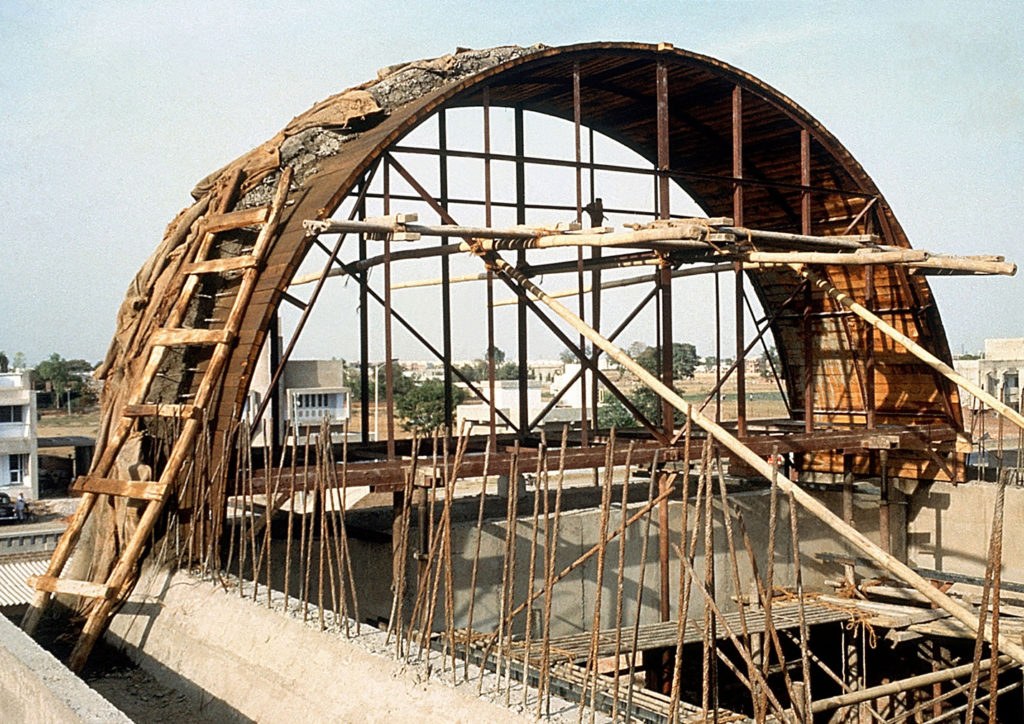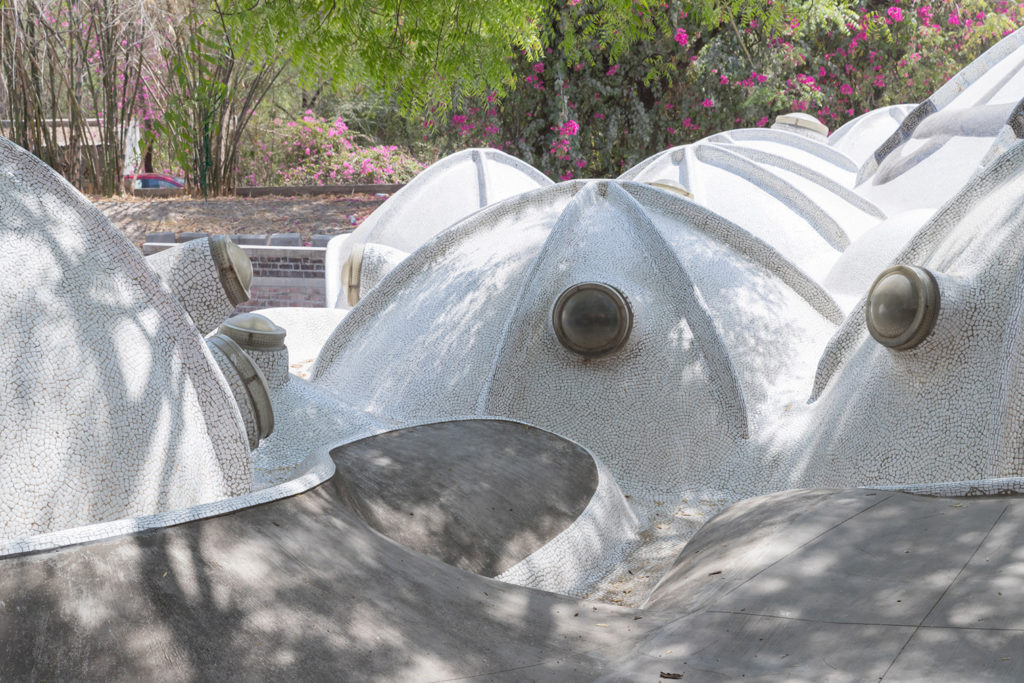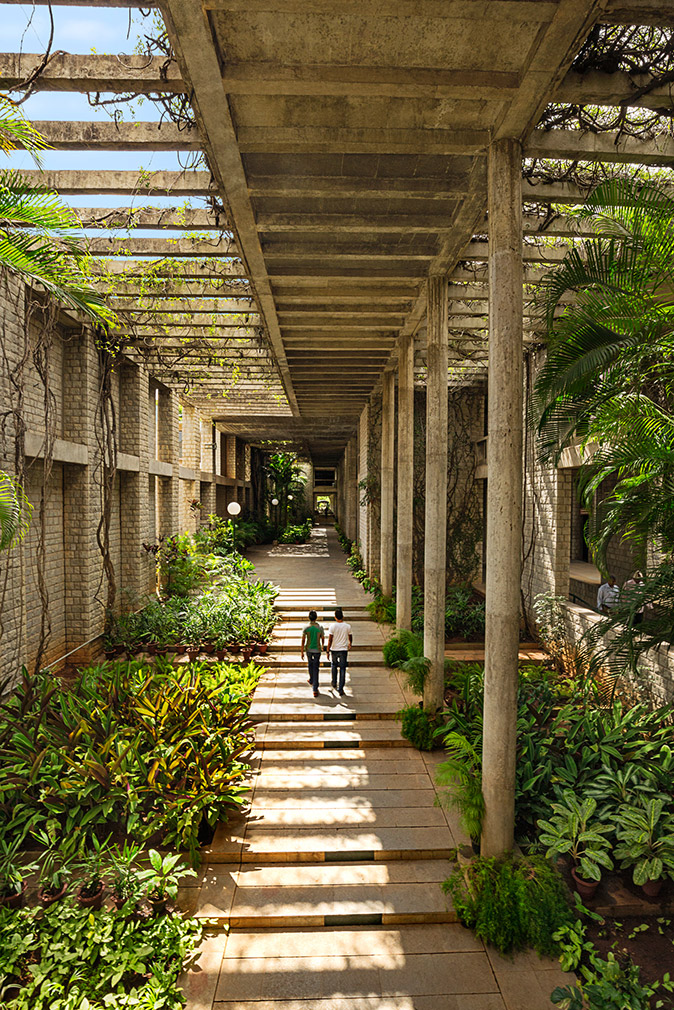The modernist brick and concrete works of the Indian architect Balkrishna Doshi, who is known for his pioneering social housing schemes, are on show at the Vitra Design Museum in Germany from 30 March.
Covering seminal projects from 1958-2014, the retrospective charts the career of the 2018 Pritzker Prize winner, whose architecture has enhanced daily life in India while fusing the modernist styles of Le Corbusier and Louis Kahn with the traditions of his country.
Here are 7 of his most important projects.

Sangath architecture studio, Ahmedabad
Vaulted spaces, reflecting pools and a grassy amphitheatre form a series of horizontal lines and half circles at Doshi’s 1980-built studio. The influence of temple architecture on its design can be seen in its barrel vaults, which recall the mound-like mediation structures known as stupas.
Photography: Iwan Baan

Sangath architecture studio, Ahmedabad
Vaulted spaces, reflecting pools and a grassy amphitheatre form a series of horizontal lines and half circles at Doshi’s 1980-built studio. The influence of temple architecture on its design can be seen in its barrel vaults, which recall the mound-like mediation structures known as stupas.
Photography: Iwan Baan

Sangath architecture studio, Ahmedabad
Vaulted spaces, reflecting pools and a grassy amphitheatre form a series of horizontal lines and half circles at Doshi’s 1980-built studio. The influence of temple architecture on its design can be seen in its barrel vaults, which recall the mound-like mediation structures known as stupas.
Photography: Iwan Baan

Amdavad Ni Gufa, Ahmedabad
Organic and futuristic shapes collide in this 1994 underground art gallery. Mushroom stem-like columns support a hollowed out chamber whose walls are covered in Maqbool Fida Husain’s colourful murals. Sci-fi mosaic tile-covered domes on ground-level cast light into space below.
Photography: Iwan Baan

Amdavad Ni Gufa, Ahmedabad
Organic and futuristic shapes collide in this 1994 underground art gallery. Mushroom stem-like columns support a hollowed out chamber whose walls are covered in Maqbool Fida Husain’s colourful murals. Sci-fi mosaic tile-covered domes on ground-level cast light into space below.
Photography: Iwan Baan

Amdavad Ni Gufa, Ahmedabad
Organic and futuristic shapes collide in this 1994 underground art gallery. Mushroom stem-like columns support a hollowed out chamber whose walls are covered in Maqbool Fida Husain’s colourful murals. Sci-fi mosaic tile-covered domes on ground-level cast light into space below.
Photography: Iwan Baan

Om Puri temple, Matar
This eye-shaped temple was built in 1998 and is meant to encourage people to open their ‘third eye’. Doshi’s combines light and shadow to give the space a spiritual quality – the pupil-like central conical structure contains a vertical open-air void which casts a beam of light down its walls.
Photography: Iwan Baan

Tagore Memorial Hall, Ahmedabad
A fortress-like concrete structure with vertical folds makes up the outer shell of this monumental building built to commemorate Tagore, India’s most famous poet. Inside the 1960s Brutalist icon stands a central free-standing, bowl-shaped seating structure held up by columns.
Photography: Iwan Baan

School of Architecture, CEPT University, Ahmedabad
The cube-like studio spaces in the School of Architecture, CEPT University – built between 1966 and 1968 – have full-length timber doors at one end, which, when opened fully, remove the barrier between indoors and outdoors, while bringing in fresh air and natural light.
Photography: Iwan Baan

School of Architecture, CEPT University, Ahmedabad
The cube-like studio spaces in the School of Architecture, CEPT University – built between 1966 and 1968 – have full-length timber doors at one end, which, when opened fully, remove the barrier between indoors and outdoors, while bringing in fresh air and natural light.
Photography: Iwan Baan

Aranya housing project, Indore
A pioneering 1989 social housing development formed of streets and squares, designed for 80,000 individuals, Aranya combines visually-interesting geometric forms and public social spaces, while providing homes to accommodate a range of incomes, from modest one-room units to spacious houses.
Photography: Iwan Baan

Aranya housing project, Indore
A pioneering 1989 social housing development formed of streets and squares, designed for 80,000 individuals, Aranya combines visually-interesting geometric forms and public social spaces, while providing homes to accommodate a range of incomes, from modest one-room units to spacious houses.
Photography: Iwan Baan

Indian Institute of Management Hostel block (IMM), Bangalore
The open courtyard and corridor spaces in the Indian Institute of Management Hostel block (IMM) are framed by columns and beamed open roofs, which create greenery-filled worlds of shadow and light. Its maze-like spaces pay homage to Fatehpur Sikri, a complex of monuments and temples in Agra.
Photography: Iwan Baan

Indian Institute of Management Hostel block (IMM), Bangalore
The open courtyard and corridor spaces in the Indian Institute of Management Hostel block (IMM) are framed by columns and beamed open roofs, which create greenery-filled worlds of shadow and light. Its maze-like spaces pay homage to Fatehpur Sikri, a complex of monuments and temples in Agra.
Photography: Iwan Baan
‘Balkrishna Doshi: Architecture for the People’ runs at the Vitra Design Museum in Weil am Rhein from March 30 until September 8 2019
Read next: 5 female architectural photographers that inspire us






















